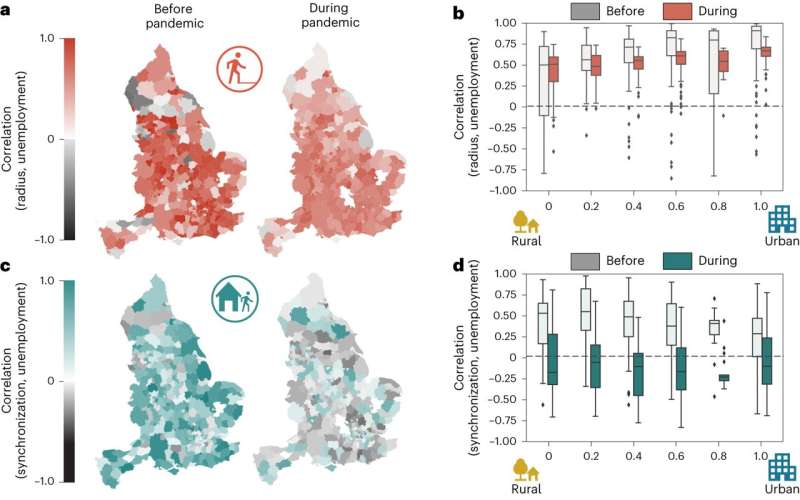This article has been reviewed according to Science X's editorial process and policies. Editors have highlighted the following attributes while ensuring the content's credibility:
fact-checked
peer-reviewed publication
trusted source
proofread
COVID lockdown: Are high-income earners more resistant to returning to the office?

Heads of organizations trying to get remote employees to return to the office may have a special challenge when it comes to their high-paid managers, according to new research by a Northeastern network science professor.
In the first paper published by Northeastern's Network Science Institute program in London, associate professor Riccardo Di Clemente and co-authors analyzed time-space mobility changes during COVID in the U.K.
The article published in Nature Human Behaviour shows that in later stages of the COVID lockdown or "soft lockdowns," people earning a high income from employment, such as those holding managerial positions, experienced less temporal mobility—meaning they were less likely to leave their homes during the day for work and were more likely to be employed remotely.
The researchers looked at anonymized cell phone data to create a mathematical model of changes in people's mobility across time and space.
"We didn't do a survey. This is from passive data collection," Di Clemente says.
They also applied census data to see how that information related to rural versus urban geographic areas as well as high- and low-income areas, he says.
"These metrics can be very useful to understand new changes (in mobility patterns)."
Lockstep before lockdown
High-income workers have the leverage to negotiate more for remote work, Di Clemente says.
"They are the ones that can actually change their synchronicity," he says, adding that part of that workforce "might never come back" to physical offices full time.
Researchers included maps that have the U.K. lighting up in red (for spatial dimensions) and blue (for temporal dimensions). The picture before the pandemic shows commuters in synchronous lockstep—leaving homes for the same amount of time at approximately the same time every day.
During the first, most restrictive part of the lockdown, nearly everybody stayed home.
Eventually people started venturing out to walk in the park or grocery shop, displaying a different time and space synchronicity from working, Di Clemente says.
Areas housing more essential workers showed that a number of people still left home for over seven hours, indicating they were going to places of employment, says Di Clemente, who worked with data provider Spectus on the research.
But people in high-income areas continued to go out for shorter periods of time even as the lockdown eased, he says.
Researchers checked activity levels in parks and found it coincided with those timeframes, indicating that people in high-income areas were leaving their homes for leisure activity, not work.
Rural picture different
The picture looked different in rural areas where farmlands abound, Di Clemente says.
Farmers and other rural workers stuck to their schedules in those areas, he says.
"They wake up at 4 a.m. and come back at 5 p.m. People were moving more or less the same," Di Clemente says.
"But spatial mobility was still limited," he says. People in rural areas couldn't go to the city for shopping or marketing purposes, for instance.
The research shows that the future may include changes in commuting patterns, job locations and eventually how cities are structured, Di Clemente says.
"Some people are starting to change the way they perceive the city," he says.
Northeastern expanded its world leading Network Science Institute to the university's campus in London this summer in a move to establish a new European hub in the fast-growing research field of network science.
As part of the expansion, the university has recruited a team of researchers, including Di Clemente, to join its faculty in the United Kingdom.
Northeastern officials say the group hails from some of the best academic institutions in Europe and their work will help scale the university's network science research globally, particularly in the areas of human health and global security.
More information: Clodomir Santana et al, COVID-19 is linked to changes in the time–space dimension of human mobility, Nature Human Behaviour (2023). DOI: 10.1038/s41562-023-01660-3
Journal information: Nature Human Behaviour
Provided by Northeastern University



















